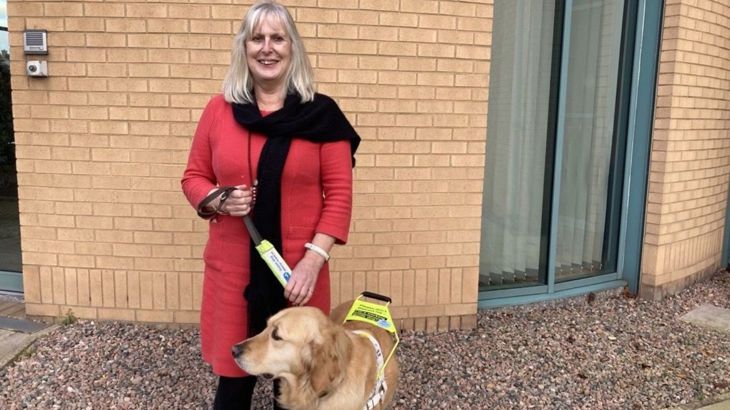Walking the streets of our cities, towns and villages should be a simple thing. But for June, who is visually impaired, it can be an enormous challenge.

June Best with her guide dog Clyde in Belfast. June is a member of disability advocacy group Imtac in Northern Ireland and is a participant in the Disabled Citizens' Inquiry conducted by Sustrans and Transport for All.
“I tell everyone that the minute I go out my front door, my adventure starts. And it is always an adventure!
“My eyesight has been transitional, and the sight that I did have has now gone. I no longer have the visual clues that I had in the past.
“I am reliant on my sense of orientation, and my hearing is very important.”
An amazing guide dog
“I have an amazing guide dog called Clyde. Sometimes I get quite emotional as I am so proud of Clyde when people tell me how he has navigated to keep me safe.
“One of my biggest challenges is vehicles parking on the pavement.
“When Clyde takes me out round a parked vehicle, I can’t tell if it’s just one car, or a whole line of them.
“I don’t know how long I will be on the road for; traffic can be very busy and can put me in danger.
“I often have to orientate myself back and start all over again to find an alternative route, or just return home.”
A street full of cars parked on the pavement
“Recently a lady tried to assist me when I encountered a street full of cars parked on the pavement on my route home.
“She said that she had never considered how much of a problem it could be until she saw me, and saw how hard Clyde was trying to get me to safety.
“Utility vehicles parked on the pavement are a nightmare – they are so big, and often park close to junctions.”
Roadworks cause chaos
“When there are roadworks, it’s chaos for me. There should be some way of letting people in the community know about these dangers.
“They are usually temporary, but it is just another street obstacle for me, and one that I don’t know about until it is right in front of me.”
Consistency is key
“The most important thing is that there is consistency, so that all pedestrians, including visually impaired people, know where obstacles will be and can factor this into their journey.
“Recently I was walking in my village and a group of cyclists had stopped at a local café. There was nowhere for them to put their bikes, so they were just lying about everywhere, propped up against windows, A-boards, trees, etc.
“It’s such a simple thing, but it was a huge hazard for me to walk past.
“If there was proper cycle parking available, the bicycles could be safely stored, and I would know exactly where they are going to be and can easily avoid them.”
Design that allows everyone to move safely
“We need inclusive design.
“I have always used public transport. In an ideal world, I could get off a train in any city or town, and safely get to where I want to be.
“But there is often so much street furniture – ‘street clutter’, as I call it. There are bins, junction boxes, signage, seating – these things are necessary, but they should be incorporated in a way that allows everyone to move safely.
“We need more delineation, so that café culture can thrive without creating a challenge to individuals.”
Shifting the focus to people
“Traffic flow often seems to be the main focus of planning. Our communities are full of everyday people going about their day with wheelchairs, prams, buggies, mobility scooters, walking aids and so on.
“The focus needs to shift to people, to ensure that our streets are accessible for everyone to navigate.
“That way, everyone’s journey can be a good adventure.”





